Coming in at number one is the Universal Audio Apollo Twin MKII Duo.
Best Electronic Drum Headphones
Unveiling the top electronic drum headphones - from budget finds to premium sound quality. Elevate your drumming experience now!
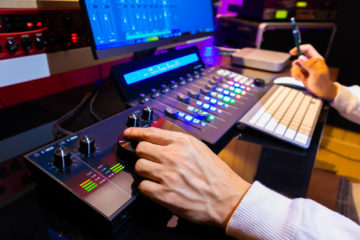
If you’re using Pro Tools as your DAW, I can only assume you’re serious about producing music. This is because Pro Tools like Cubase have a higher learning curve than other DAWs and are usually meant for professional studios.
Pro Tools also isn’t that friendly in terms of compatibility. If the audio interface doesn’t explicitly support Pro Tools, you most likely won’t get the best performance.
The Universal Audio Apollo Twin MKII Duo is the best audio interface for Pro Tools. This audio interface features exceptional preamps, an analog design, and high-quality components. The powerful processing power on this interface offers extremely low latency for smooth and flawless recording and tracking. For a home studio, this is the best entry-level professional interface.
Keep in mind that this audio interface isn’t the actual ‘best’ audio interface in terms of price. Instead, it’s the best interface in terms of value.
Audio interfaces can range upwards of $10,000 for the most premium models. If you’re looking to produce music in your bedroom, these ultra-luxurious audio interfaces aren’t worth it.
The Apollo Twin MKII Duo offers more than enough performance for professional-sounding audio quality.
| Best for Professional Recordings Audio Interface For Pro ToolsSee On Amazon | 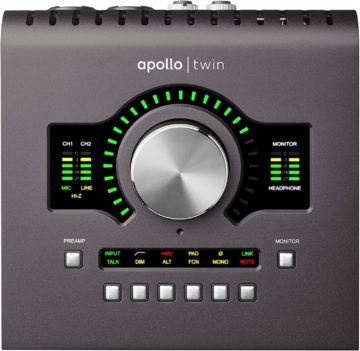 | Universal Audio Apollo Twin MKII Solo | See On Amazon |
| Best Premium Audio Interface For Pro ToolsSee On Amazon | 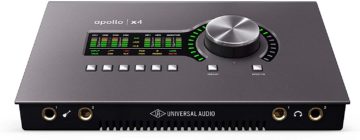 | Universal Audio Apollo x4 Heritage Edition | See On Amazon |
| Best Flagship Audio Interface For Pro ToolsSee On Amazon |  | Apogee Symphony I/O Mk II | See On Amazon |
| Best USB Audio Interfaces for Pro ToolsSee On Amazon | 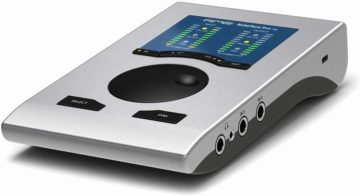 | RME Babyface Pro FS | See On Amazon |
| Best Budget Audio Interface For Pro ToolsSee On Amazon | 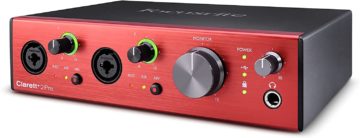 | Focusrite Clarett+ 2Pre | See On Amazon |
| Most Affordable Audio Interface For Pro ToolsSee On Amazon | 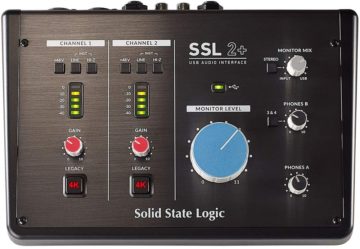 | Solid State Logic SSL2+ | See On Amazon |
Coming in at number one is the Universal Audio Apollo Twin MKII Duo.
This is the audio interface to get if you’re serious about upgrading your music production without needing to dish out thousands and thousands of dollars.
There’s a reason why this audio interface is the best selling interface for small professional studios and bedroom studios. This interface comes with a variety of useful features, including Unison preamps and access to the entire UAD catalog.
Universal Audio is known for their superiority in both hardware and software. Although this is an entry-level Universal Audio interface, it’s still better than anything else you might find in this category.
The Apollo Twin MKII Duo has a two-input design for either mic or line and a simple layout. It also features a digital input which allows for eight additional inputs via ADAT.
If you have a cheap audio interface or don’t even have one, the Apollo Twin is one of the best investments you’ll ever make in terms of audio gear. The overall completeness of the Apollo Twin makes it an easy winner in the professional bedroom audio interface quality.
The build quality is immense and very sturdy when it’s placed on a table. Furthermore, the controls are centered around a large knob whose function is chosen by pressing the surrounding buttons.
It’s an intuitive device and I’ve never needed to look at the instruction manual once. The only issue is that you may sometimes reach down to turn up the monitor volume to find out that you’ve raised the mic gain.
In terms of sound quality, the Apollo Twin MKII Duo is good enough for professional recordings. There are numerous hits that have been recorded using an Apollo audio interface.
Although there are other audio interfaces with better converters and I/O, the Apollo stands out because of its integrated DSP that allows you to run Universal Audio’s professional-grade plugins. You can directly run these plugins on input with near-zero latency regardless of your PC setup.
If you want to step it up a notch from the Apollo Twin Duo, the Apollo x4 Heritage Edition is the upgrade you’re looking for.
With a price tag of around $2,200, you can rest assured that this audio interface is an absolute powerhouse. This interface features a tremendous amount of features and quality in a single unit.
Apollo x4’s A/D conversion captures audio in 24-bit, 192 kHz quality which provides 127dB of dynamic range for superior signal quality.
It also boasts a powerful quad-core processor that allows you to track and mix with precise emulation of tried-and-true studio classics. With sub-ms latency, four Unison mic preamps, and ample expandability, you can never go wrong with this audio interface.
The best part about this audio interface on top of its impeccable sound quality is the software bundle it comes with. The Apollo x4 Heritage Edition comes equipped with 10 of Universal Audio’s award-winning plugins and the Realtime Analog Classics Plus bundle.
These plugins include:
Each included plugin will elevate your music production and overall sound quality. All in all, the Apollo x4 is a premium desktop audio interface with outstanding conversion and preamps.
If your budget knows no limits and you want the best of the best, the Apogee Symphony I/O Mk II is calling your name.
Coming in over $5,000 MSRP for the 16×16 model, this flagship audio interface is equipped with three decades of research and development from Apogee.
It’s equipped with Apogee’s most advanced AD/DA conversion, near-zero latency, and a flexible, modular I/O system that enables up to 32 inputs and outputs.
There is also an easy-to-use touchscreen interface that offers a Tesla-like experience. This is truly a state-of-the-art audio interface that you’ll see in professional studios all across the world.
The Symphony Mk II coupled with my Macbook Pro and Pro Tools is unbelievably powerful. I prefer to record at much higher sample rates (96 to 192k) depending on the project. This is possible with this interface and the audio quality and performance are outstanding.
With countless Grammy-winning artists, records, songwriters, and engineers using this audio interface, the proof is in the pudding.
However, it’s unlikely you’ll need an audio interface of this quality for your bedroom studio. The Apogee Symphony Mk II should only be used in a professional setting.
The Apollo Twin Duo is a better choice that provides relatively similar performance (to untrained ears) at a fraction of the cost.
The RME Babyface Pro FS is one of the best USB audio interfaces for Pro Tools.
This professional-level 12-in/12-out portable interface features top-notch AD/DA conversion and SteadyClock/femtosecond technology for ultra-stable clocking.
The Babyface’s two digitally controlled preamps achieve reference-quality recording, while a full complement of digital, analog, and MIDI connectivity makes studio integration a breeze.
This interface also features one of the most fully flexible built-in digital mixers with 288 channels, 46-bit internal resolution, and latency-free processing. It also comes equipped with a 3-band EQ, low-cut filter, reverb, and echo.
The onboard metering on the Babyface Pro FS is among the best with peak and RMS presentation. This interface also includes a premium plugin bundle with contributions from Brainworx, Scuffham, and more.
This small, portable, and well-built unit holds on to everything that makes Babyface so special as an audio company. It’s a rock-solid, 24-channel interface with flawless sound and incredibly stable clocking abilities.
If you’re looking for an entry-level professional audio interface for Pro Tools, you can’t go wrong with the RME Babyface Pro FS. Although it’s not as high-end as other ultra-professional interfaces you see at record label studios, the sound it offers is reference-quality.
The interface has four analog inputs – two line inputs on the right side and two on the back panel, which can function both as line and XLR inputs.
Next to these line inputs are two headphone outputs. One accepts a full-sized ¼ inch jack and the other one a mini-jack.
Overall, the Babyface Pro FS’s performance has been upgraded in every aspect compared to the older generation. The microphone preamps now share an SNR of 113.7 dB compared to the original’s 112.2 dB.
This is one of the best home studio audio interfaces you can currently purchase due to its compact size which can be placed anywhere.
Furthermore, the Babyface can be compared to the Apollo Twin Duo, which is the best Thunderbolt audio interface.
Just underneath the RME Babyface lies the Focusrite Clarett+ 2Pre.
This audio interface is half the price of the Babyface but offers excellent audio quality and is one of the best audio interfaces for windows.
The Focusrite Clarett+ 2Pre comes with all the features from the original version but also includes custom microphone preamps and extremely low latency. It’s equipped with the newly chosen D/A converters and a high-quality output filter circuit that gives you a larger dynamic range and lower noise floor.
Furthermore, Clarett+ interfaces come with Focusrite’s famous Air circuit. The ADAT input also allows you to bring in eight additional mic-preamp channels.
This audio interface is a USB 2.0 compatible device and the connection is via a USB-C port on the back of it. It also supports USB-C bus powering, but you’ll need a USB-C equipped device that provides 15W power.
The Focusrite Clarett+ 2Pre works in conjunction with the Focusrite Control software program. This means that some functionality including selecting the instrument input is only accessible via the software.
Luckily, the software is easy to use, and setting up your low latency monitoring is very straightforward.
From my experience, the mic inputs are silky smooth and have lots of headroom for flexibility.
Furthermore, the outputs are crystal clear and pleasantly noise-free.
All in all, the Clarett+ 2Pre is an affordable audio interface that will exponentially boost your experience with Pro Tools.
If you’re searching for the world-renowned SSL sound, the Solid State Logic SSL2+ is exactly what you need.
This audio interface features two top-shelf mic preamps, outstanding converters, and enough I/O to fit into any project studio.
The SSL2+ also hosts a 4K Legacy mode, which embodies genuine SSL 4000 series analog console tone quality to each of your recordings. With this mode engaged, you’ll receive a high-frequency EQ boost and a sprinkle of subtle harmonic distortion that makes your signals come to life.
Best of all, this unit is built like a tank. It will endure years of hard use in your studio. It’s also the most affordable USB audio interface for Pro Tools on this list today.
The Solid State Logic SSL2+ works for Mac or PC. It’s a rock-solid, 2-in/4-out audio interface that includes 24-bit/192 kHz AKM converters, Alp pots, Neutrik connections, and more.
There’s also a robust selection of software, including Bomb Factory plug-ins, Hybrid Keys, Komplete Start, Pro Tools First, and an SSL Native software bundle.
Now the big question at hand – is this budget audio interface worthy of the SSL name? The answer is a definitive “YES”.
What really sets this interface apart is that immediately out of the gate, the SSL 2+ puts more desirable traits straight into my DAW (Pro Tools) than any interface I’ve ever played through.
The tracking on this interface was also seamless due to this device’s low latency. Solid State Logic knocked this budget-friendly audio interface out of the park. It complements almost every practical use I can imagine out of a two-channel mixer.
This is truly the best bang for your buck without needing to sacrifice sound quality or flexibility.
This wraps up the list of the best audio interfaces for Pro Tools. The best audio interface for you will depend on your budget, your connection type, and how many ports you need. After you reach a certain budget, the audio quality gains will offer diminishing returns.
So, any of the audio interfaces on this list today will instantly enhance your studio and sound. If you’ve never used an audio interface before, you’ll be amazed at how much they can improve every aspect of music production.
In fact, most professional engineers recommend upgrading your audio interface before your microphone. This is because the audio interface processes all the vocals and instruments.